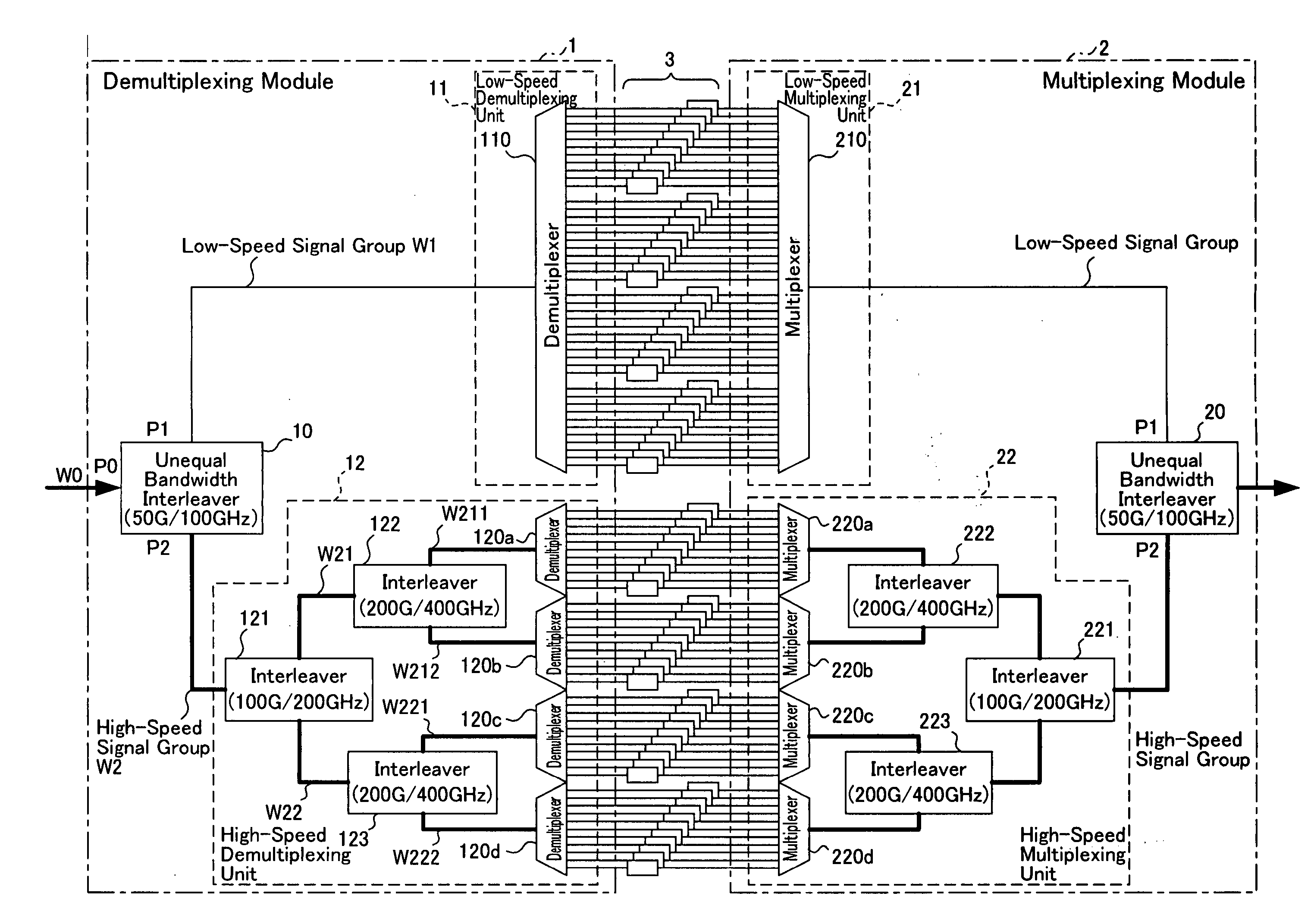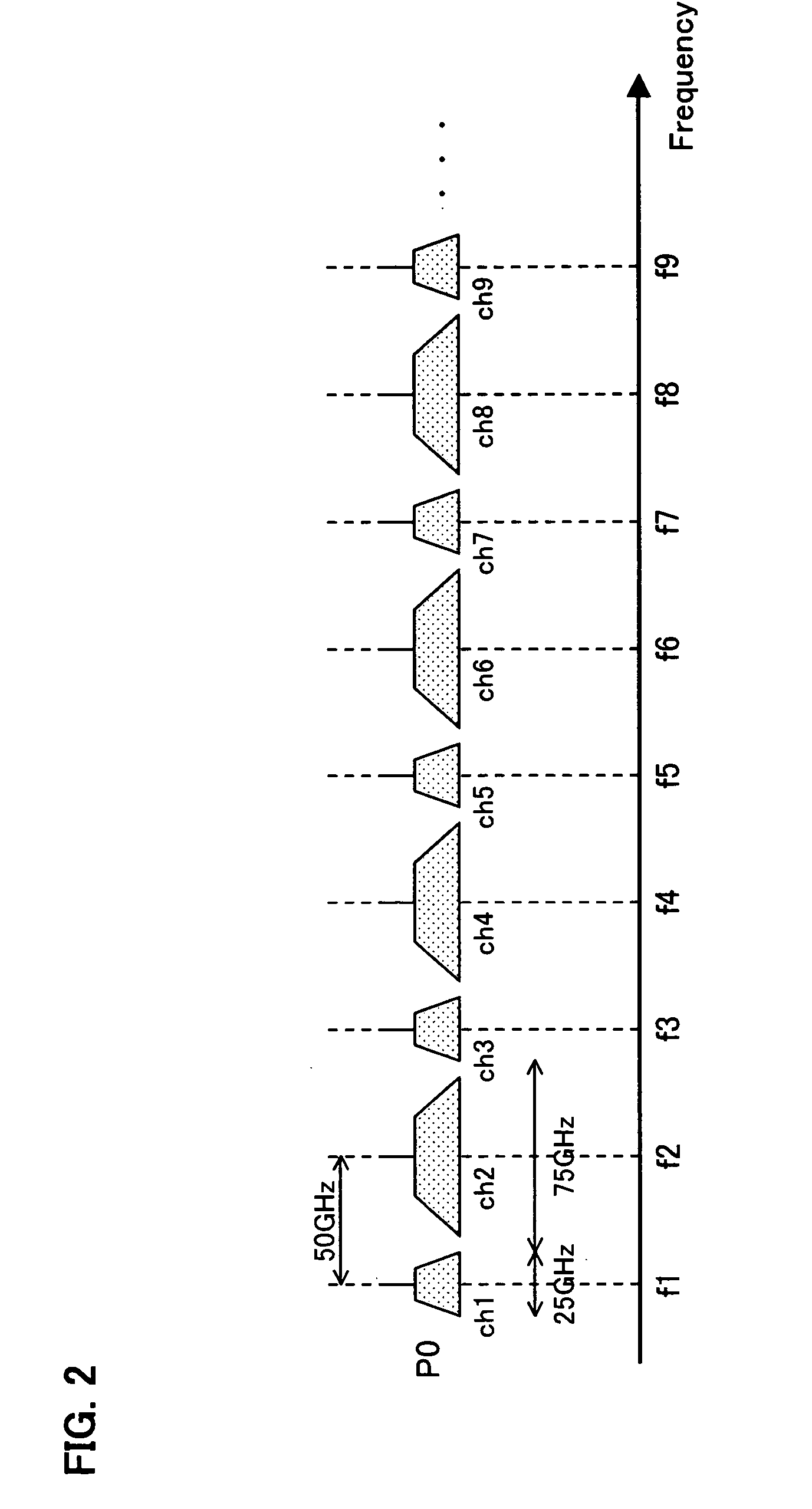Wavelength division multiplexing transmission system
a transmission system and wavelength division technology, applied in wavelength-division multiplex systems, multiplex communication, electromagnetically repeaters, etc., can solve the problems of increasing cost, requiring higher performance and specifications, and difficulty in upgrading an arbitrary channel to 40 gbit/s, etc., to achieve high function devices, high performance, and cost reduction
- Summary
- Abstract
- Description
- Claims
- Application Information
AI Technical Summary
Benefits of technology
Problems solved by technology
Method used
Image
Examples
embodiment 1
[0060]FIG. 1 is a block diagram depicting the configuration of the optical transmission node according to the first embodiment of the present invention. This optical transmission node is a relay node which is installed in the wavelength division multiplexing (WDM) transmission system, and is comprised of a demultiplexing module 1 and a multiplexing module 2. In the present embodiment, the relay node will be described as an example, but the present invention can be applied not only to the relay node of the WDM transmission system but also to the transmission terminal or the reception terminal of the WDM transmission system. For example, in the transmission terminal, only the multiplexing module 2 is installed, and in the reception terminal, only the demultiplexing module 1 is installed. The present invention can be applied to the transmission terminal or the reception terminal in this way, which is the same for the second to twelfth embodiments herein below.
[0061] The demultiplexing...
embodiment 2
[0095]FIG. 5 is a block diagram depicting the configuration of the optical transmission node according to the second embodiment of the present invention. This optical transmission node comprises a demultiplexing module 1a and a multiplexing module 2a.
[0096] The demultiplexing module 1a is comprised of an unequal bandwidth interleaver 10a, low-speed demultiplexing unit 11a, and high-speed demultiplexing unit 12a. The low-speed demultiplexing unit 11a is further comprised of multiplexers for low-speed signals 110a and 110b. The high-speed demultiplexing unit 12a is further comprised of interleavers for highs-speed signals 122 and 123, and demultiplexers for high-speed signals 120a through 120d. The interleavers 122 and 123 and the demultiplexers 120a through 120d are the same as those denoted with the same reference symbols in FIG. 1.
[0097] The multiplexing module 2a is comprised of an unequal bandwidth interleaver 20a, low-speed multiplexing unit 21a and high-speed multiplexing uni...
embodiment 3
[0141]FIG. 11 is a block diagram depicting the configuration of the optical transmission node according to the third embodiment of the present invention. This optical transmission node comprises a demultiplexing module 1b and a multiplexing module 2b.
[0142] The demultiplexing module 1b is comprised of an unequal bandwidth interleaver 10, low-speed demultiplexing unit 11b, and high-speed demultiplexing unit 12b. The low-speed demultiplexing unit 11b is further comprised of demultiplexers for low-speed signals 110 and 111. The high-speed demultiplexing unit 12b is further comprised of interleavers for high-speed signals 121 and 123, and demultiplexers for high-speed signals 120c and 120d. The multiplexing module 2b is comprised of an unequal bandwidth interleaver 20, low-speed multiplexing unit 21b, and high speed multiplexing unit 22b. The low-speed multiplexing unit 21b is further comprised of the multiplexers for low-speed signals 210 and 211. The high-speed multiplexing unit 22b ...
PUM
 Login to View More
Login to View More Abstract
Description
Claims
Application Information
 Login to View More
Login to View More - R&D
- Intellectual Property
- Life Sciences
- Materials
- Tech Scout
- Unparalleled Data Quality
- Higher Quality Content
- 60% Fewer Hallucinations
Browse by: Latest US Patents, China's latest patents, Technical Efficacy Thesaurus, Application Domain, Technology Topic, Popular Technical Reports.
© 2025 PatSnap. All rights reserved.Legal|Privacy policy|Modern Slavery Act Transparency Statement|Sitemap|About US| Contact US: help@patsnap.com



